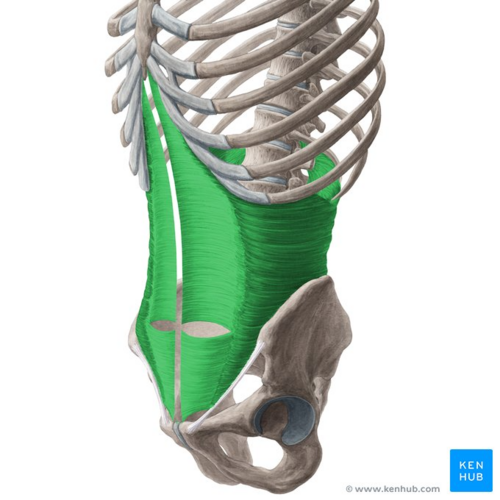Diastasis Recti: Another Type of Separation Anxiety
Diastasis recti abdominis (DRA) is a condition where the rectus abdominis, the glamour muscles you see in a “6-pack,” separates at the midline dense connective tissue called the linea alba, most commonly seen during pregnancy and postpartum, but can occur from over-distention of the abdomen. This includes obesity with increased visceral fat and doesn’t discriminate against men. Yes, in one way, men can experience glimpse of what pregnancy can do to your body, albeit a different causation.
Diastasis recti abdominis sounds like a complicated and painful medical condition, but surprisingly, it’s not. Since DRA is usually pain-free, the major concerns reported are the visible change of tone in the abdominal muscles and the lack of core strength.

Let’s talk about what happens during pregnancy and why you experience DRA. Aside from the growing fetus and amniotic fluid, we have a huge surge in hormones, one of them called relaxin, which literally relaxes all the ligaments and joints of the body. This is to allow our bodies to stretch and accommodate another human to grow inside our bellies and to open the pelvis for delivery. So the effects of relaxin on our rectus abdominis may not be so noticeable during pregnancy, but in postpartum, can be a drastic change from pre-pregnancy. There is no need to panic, first of all because this happens in 100% of pregnancies (if you were pregnant, you experienced DRA), hormonal levels can take up to 2 years to normalize, there is usually no pain involved with the disruption of the connective tissue, and physical therapy can help create an appropriate exercise program for you.
Let's also take a moment to appreciate DRA. This has to happen in order for your baby to have space to grow. Your body's ability to separate your abdominal wall to allow for your baby to grow, and its ability to heal once you've had your baby is remarkable.
The rectus abdominis will typically start to approximate together slowly postpartum, but the primary emphasis on physical therapy intervention is that core strength and tension across the abdominal wall is returned to promote trunk support and normalize intra-abdominal pressure.
If left untreated, this could lead to:
- upper back/low back pain
- hip pain
- pelvic floor issues
- bowel or bladder incontinence
- prolapse
- constipation
- painful sex
- difficulty controlling posture
As you can see, this can impede many of our daily functions or even more so, higher level exercise. While DRA is not dangerous and is absolutely treatable, we often see women who returned to high-level activity too soon postpartum. At your 6 week check up you are generally encouraged to return to all activity as normal including sex, running, jumping, heavy lifting etc. There is a consensus in the pelvic floor world that this advice is *insane.* Your body has been through radical change and hasn't engaged in high-impact activity in at least 2 months (much, much longer for most), and your body has been under immense physical stress for much longer than that. Just like we rehabilitate from injuries, we have to rehabilitate from pregnancy and birth. When you return to activity too soon, it can place more stress through the dense connective tissue of the abdomen and rectus abdominis and exacerbate the separation, making it more severe and therefore it lasts longer.
Just like we rehabilitate from injuries, we have to rehabilitate from pregnancy and birth.
A physical therapist can manually assess and measure the amount of separation between the rectus abdominis, as well check for what we call “coning.” This is when the muscles and organs bulge into a cone-like shape, distending beyond the abdomen because there is not enough tension across the abdomen to maintain equal pressure across the core.
In the early stages of postpartum (at least the first 3 months), it is important to avoid over-working the rectus abdominis with exercises such as your typical crunches or leg lifts, but that doesn’t mean you will always have to avoid them. The body is still healing, and time is needed to strengthen the rectus abdominis slowly, as well as the other important supporting core muscles.
A major player in recovery from DRA is the transverse abdominis. It is our natural corset muscle, which lies between our hip bones and studies have shown reduced linea alba distortion with pre-contraction of this fabulous muscle. It also co-contracts with our pelvic floor, supports our spine and hips, and assists with breathing and pressure management for things like coughing, exercising, and passing bowel movements. If you are pregnant or postpartum, this is the muscle that takes the longest to strengthen because this is the muscle of the lower abdomen that sustains most of the stretching and stress of pregnancy. Strengthening this muscle can look different for everyone and highly depends on how it tolerated pregnancy.

It's so important to get guidance from a physical therapists who specializes in the pelvic floor to provide you with a plan that is tailored to your body, your strengths, your movement, and your goals to prevent worsening your DRA, and optimize your healing and return to activity.
Hopefully, this post mitigated some anxiety about diastasis recti because it is an extremely common and natural condition that very treatable by physical therapy. Remember, the goal is to return to optimal function so that you can take care of your baby and your body safely, without pain or limitations.



